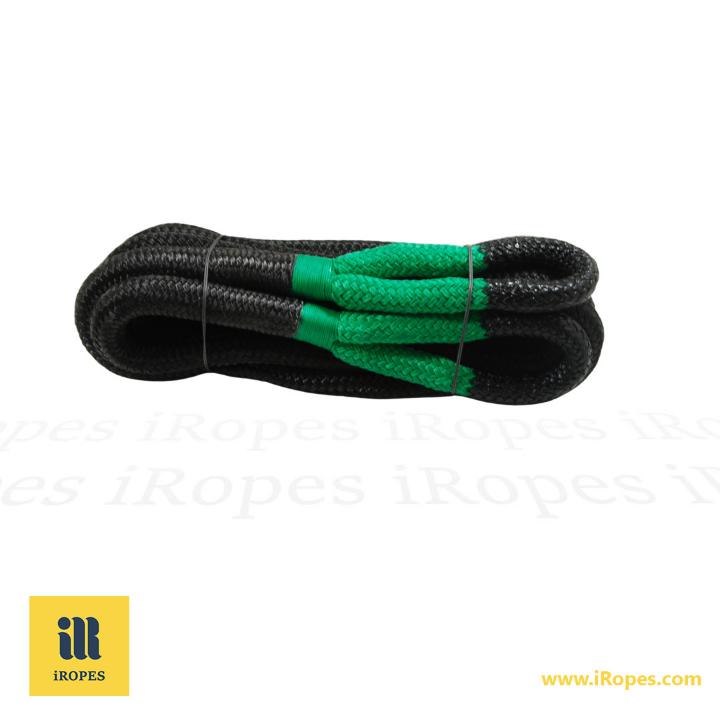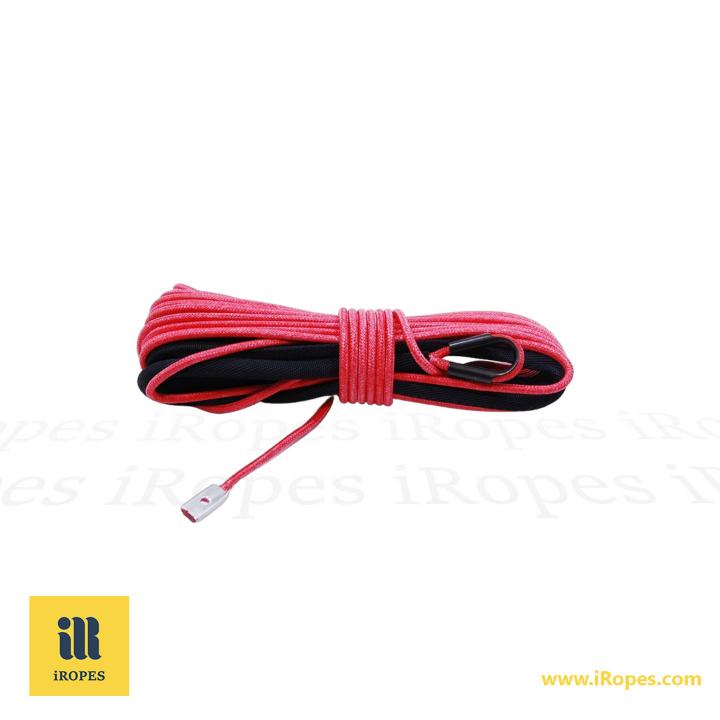Have you ever wondered why your 4x4 recovery rope stretches like a rubber band, while your garden twine snaps under the slightest strain? The answer lies in the fascinating world of rope tensile strength, where nylon and hemp battle it out for supremacy. As an expert rope manufacturer, we at iRopes have seen firsthand how the right choice of material can mean the difference between a successful off-road adventure and a costly mishap.
In this eye-opening comparison, we'll unravel the mysteries behind the tensile strength of nylon rope and hemp rope tensile strength, exploring why the breaking strength of nylon rope makes it the undisputed champion for off-road recovery. You'll discover why nylon's high elastic properties and superior strength make it the go-to choice for kinetic recovery ropes, while hemp finds its niche in eco-friendly applications.
Whether you're a weekend warrior or a seasoned off-road enthusiast, understanding these crucial differences could save your vehicle - and your pride - on your next expedition. So buckle up and get ready to dive into the world of rope tensile differences. Trust us, by the end of this article, you'll never look at a simple rope the same way again.
Understanding Nylon Rope Tensile Strength
When it comes to choosing the right rope for your needs, understanding tensile strength is crucial. As an avid outdoorsman and rope enthusiast, I've learned that nylon rope's tensile strength is one of its most impressive features. Let's dive into what this means and why it matters.
Defining Tensile Strength and Breaking Strength
Tensile strength, also known as breaking strength, is the maximum load a rope can bear before breaking. For nylon rope, this strength is typically measured at an impressive 12,400 psi (pounds per square inch). Imagine trying to snap a pencil-thick nylon rope with your bare hands - it's practically impossible!
It's important to note that tensile strength is measured under controlled laboratory conditions. In real-world applications, we use a concept called "working load," which is typically 8-11% of the rope's tensile strength. This ensures a significant safety margin in practical use.
Factors Affecting Nylon Rope Strength
- Rope diameter: Generally, thicker ropes have higher tensile strength.
- Construction: 3-strand or 8-strand designs affect overall strength.
- Environmental factors: Moisture and UV exposure can impact rope integrity over time.
- Wear and tear: Knots and abrasion can reduce a rope's strength significantly.
Calculating and Testing Nylon Rope Tensile Strength
Curious about how we determine a rope's breaking strength? Here's a simplified formula:
Breaking Strength (lbs) = (Diameter in inches)² × 12,400
Professional testing involves sophisticated machines using capstans to apply increasing loads until the rope breaks. This precise method ensures accuracy in determining a rope's true strength.
Understanding nylon rope's tensile strength is essential for making informed decisions about rope selection. Whether you're planning a climbing expedition or securing heavy loads, knowing your rope's capabilities can make all the difference in safety and performance.
Have you ever experienced the surprising strength of nylon rope firsthand? Share your stories in the comments below!
Exploring Hemp Rope Tensile Strength
As we delve deeper into the world of ropes, it's fascinating to explore the unique properties of hemp rope. Having worked with various rope materials over the years, I've come to appreciate the natural strength and versatility of hemp. Let's unravel the mysteries of hemp rope tensile strength together.
Understanding Hemp Rope Composition
Stainless steel black Tube thimble, 1.5M length black Sleeve, the other Sidesilver
Mounting lug
MATERIAL: UHMWPEcore UHMWPE cover 24
CONSTRUCT: double braided
ELONGATION: 5.20%
Hemp ropes are crafted from the fibres of the Cannabis sativa plant, but don't worry – they won't get you high! These fibres are renowned for their robustness and durability. When I first held a hemp rope, I was struck by its coarse texture and earthy scent – a tactile reminder of its natural origins.
The strength of hemp rope lies in its unique fibre structure. Each strand is composed of countless tiny fibres twisted together, creating a rope that's both strong and flexible. It's this intricate composition that gives hemp its impressive tensile strength.
Measuring Tensile Strength in Hemp Ropes
Now, you might be wondering, "Just how strong is hemp rope?" Well, let's crunch some numbers. On average, hemp fibres boast a tensile strength of 277±191 MPa (megapascals) and a tensile modulus of 9.5±5.8 GPa (gigapascals). In layman's terms, that's pretty darn strong!
Hemp Rope Strength
Tensile Strength: 277±191 MPa | Tensile Modulus: 9.5±5.8 GPa
But what do these numbers mean in real-world applications? Well, a 10mm diameter hemp rope can typically support a working load of about 200kg. That's enough to hoist a full-grown kangaroo!
Comparing Hemp Rope Strength to Other Materials
When it comes to natural fibres, hemp is a heavyweight champion. It outperforms other plant-based ropes like sisal in terms of tensile strength. However, it's important to note that synthetic ropes, particularly HMPE (High Modulus Polyethylene), still reign supreme in overall strength.
Here's a quick comparison to give you a better picture:
- Hemp: Strong, biodegradable, and UV-resistant.
- Sisal: Slightly weaker than hemp, but still a popular natural choice.
- Nylon: Stronger than hemp, with excellent elastic properties.
- HMPE: The strongest commercially available rope material.
While hemp might not be the strongest rope on the market, it offers a unique blend of strength, sustainability, and character that many find appealing. I've used hemp ropes for various outdoor projects, from garden trellises to makeshift clotheslines, and they've always served me well.
Have you ever used hemp rope for a project? How did it perform? Share your experiences in the comments below – I'd love to hear your thoughts!
Breaking Strength Comparison: Nylon vs Hemp Rope
As an avid rock climber and outdoor enthusiast, I've had my fair share of experiences with different types of ropes. Today, let's dive into the fascinating world of breaking strength, comparing nylon and hemp ropes. Understanding these differences is crucial for anyone who relies on ropes for safety or utility.
Characteristics of Nylon and Hemp Ropes
Picture this: you're holding two ropes, one smooth and slightly elastic, the other rough and fibrous. That's the tactile difference between nylon and hemp. Nylon ropes feel almost silky to the touch, while hemp has a coarse, natural texture that reminds you of its organic origins.
- Nylon: Synthetic, elastic, and highly resistant to abrasion.
- Hemp: Natural, biodegradable, and known for its impressive strength-to-weight ratio.
These characteristics play a significant role in determining their breaking strength. But what exactly is breaking strength?
Understanding Breaking Strength
Breaking strength, also known as tensile strength, is the maximum load a rope can handle before it snaps. It's like the ultimate test of a rope's mettle. Imagine trying to pull apart a thick rubber band – the point at which it finally breaks is its breaking strength.
Breaking strength is typically measured in pounds (lbs) or kilonewtons (kN). For example, a high-quality 10mm nylon climbing rope might have a breaking strength of around 6,000 lbs or 27 kN.
Nylon's Superior Breaking Strength
When it comes to sheer breaking strength, nylon often outperforms hemp. In my years of experience, I've seen nylon ropes withstand incredible forces that would snap a hemp rope of similar diameter. This superior strength is one reason why nylon is the go-to choice for many high-stress applications.
For instance, during a rock climbing expedition in the Rockies, I witnessed a nylon rope effortlessly absorb the shock of a fall that I'm certain would have been too much for a hemp rope to handle. It's moments like these that really drive home the importance of choosing the right rope for the job.
Factors Affecting Rope Strength
Several factors influence a rope's breaking strength:
- Diameter: Generally, thicker ropes are stronger.
- Construction: Braided ropes often have higher breaking strengths than twisted ones.
- Environmental conditions: UV exposure, moisture, and temperature can affect rope strength over time.
- Age and wear: Even the strongest ropes weaken with use and age.
Applications and Use Cases
While nylon shines in high-stress scenarios, hemp has its place too. Here's a quick rundown of where each rope type excels:
- Nylon: Ideal for climbing, boating, and heavy-duty industrial applications.
- Hemp: Great for decorative purposes, garden use, and eco-friendly projects.
Remember that time I tried using a hemp rope for a makeshift tire swing? Let's just say I quickly switched to nylon after a few nerve-wracking creaks!
Understanding the breaking strength differences between nylon and hemp ropes is crucial for making informed decisions. Whether you're scaling a cliff face or tying up your tomato plants, choosing the right rope can make all the difference.
Have you had any experiences where rope strength made a significant difference? Share your stories in the comments below – I'd love to hear them!
Choosing the Right Nylon Rope for Off-Road Recovery
When it comes to off-road adventures, having the right recovery gear can make or break your expedition. As someone who's been stuck in more mud pits than I care to admit, I can tell you firsthand that a reliable recovery rope is worth its weight in gold. Let's dive into why nylon ropes, particularly kinetic recovery ropes, are the go-to choice for off-road enthusiasts like myself.
Understanding Kinetic Recovery Ropes
Kinetic recovery ropes are a game-changer in the world of vehicle recovery. Unlike traditional tow straps, these ropes are designed to stretch and store energy, much like a bungee cord. This stretching action absorbs the initial shock of the pull, reducing the risk of damage to both vehicles and making the recovery process smoother and safer.
The secret sauce? Nylon. The nylon construction of kinetic recovery ropes gives them their elastic properties, allowing for that crucial 20-30% stretch capacity. I remember the first time I used a kinetic rope to pull my mate's 4x4 out of a bog - the way it smoothly transferred the energy felt almost magical compared to the jarring yank of a static rope.
Kinetic recovery ropes can stretch up to 30% of their length, absorbing shock and reducing the risk of vehicle damage during recovery.
Selecting the Proper Strength and Size
Choosing the right rope isn't just about picking the strongest one you can find. It's about finding the perfect balance for your vehicle and recovery needs. Here's a simple formula I swear by:
- Rope strength: Should be at least 3 times your vehicle's gross weight.
- Diameter: Typically ranges from 7/8" to 1-1/4" for most off-road vehicles.
- Length: A 30-foot rope is versatile for most situations, but longer options are available for specific needs.
For example, if you're driving a 4,000 lb SUV, you'd want a rope with a minimum breaking strength of 12,000 lbs. Trust me, when you're axle-deep in mud, you'll be glad you did the math.

For more in-depth information about choosing the right kinetic recovery rope, check out our Essential Tips and Safety Advice for selecting the best recovery rope.
When it comes to brands, you can't go wrong with industry leaders like Rhino USA, Bubba Rope, or ARB. These companies have put their ropes through the wringer, ensuring they can handle the toughest recovery scenarios.
Plus, Nylon double braided ropes can be especially effective for off-road recovery due to their strength and elasticity. This makes them perfectly suited for heavy-duty tasks where maximum performance is required.
Remember, the right nylon rope isn't just about getting you unstuck - it's about doing so safely and efficiently. Whether you're a weekend warrior or a seasoned off-road veteran, investing in a quality kinetic recovery rope is one decision you won't regret. Have you had any memorable recovery experiences with nylon ropes? Share your stories in the comments below!
Choosing the right rope is essential for safety and performance across various applications. The tensile strength of nylon rope is renowned for being exceptionally high, ensuring impressive durability and elasticity, making it ideal for high-stress uses like off-road recovery. In contrast, hemp rope tensile strength, though robust, doesn't quite match nylon's breaking strength. These differences highlight why nylon, with its superior elasticity and breaking strength, is recommended for recovery kinetic ropes. Its ability to withstand substantial stress makes it the preferred choice for off-road scenarios, providing reliable and safe solutions when maximum tensile performance is needed.
Discover the Perfect Rope Solution for Your Needs
Fill in the inquiry form located above for a closer look at custom rope solutions that match your specific requirements. Our experts at iRopes are ready to assist you in finding the perfect balance between strength and functionality, ensuring your next project is a success.
```